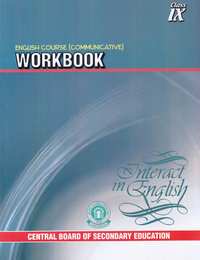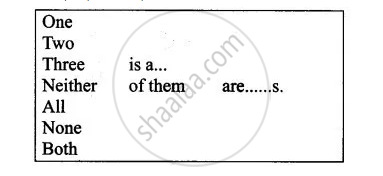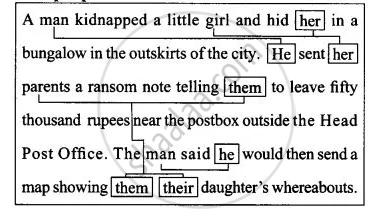Advertisements
Chapters
1.2: Integrative Grammar Practice 1
▶ 2.1: Determiners
2.2: Integrative Grammar Practice 2
3.1: Future Time Reference
3.2: Integrative Grammar Practice 3
4: Modals
5.1: Connectors
5.2: Integrative Grammar Practice 4
6.1: The Passive
6.2: Integrative Grammar Practice 5
7.1: Reported Speech
7.2: Integrative Grammar Practice 6
8.1: Prepositions
8.2: Integrative Grammar Practice 7

Advertisements
Solutions for Chapter 2.1: Determiners
Below listed, you can find solutions for Chapter 2.1 of CBSE CBSE for English Communicative - Workbook Interact in English Class 9.
CBSE solutions for English Communicative - Workbook Interact in English Class 9 2.1 Determiners Exercises [Pages 21 - 32]
Complete the introduction given below to the story The Story Teller by Saki (H.H. Munro), by using ‘a’ ‘art’ or ‘the’’:
The afternoon was hot, and so was (a)______ railway carriage. (b)_______ next stop was at Templecombe, nearly (c)______ hour ahead. In the carriage were a small girl, (d)______ smaller girl, and a small boy. (e)________ aunt belonging to (f)______ children sat in (g)_________ comer seat, and in (h)_______ further comer seat on (i)______ opposite side, was a man who was a stranger to them, but (j)_____ small girls and the small boys were (k)_________ ones who filled the compartment. The children chatted on and on to their aunt, like (l)____ housefly that refuses to be put off. Most of the aunt’s remarks seemed to begin with “Don’t”, and nearly all of (m)______ children’s remarks began with “Why?”
(a) Answer the following questions:
- Where were the characters at the time of narration?
- Who was travelling with the aunt?
- How did the children pass their time?
- How long would they take to reach Templecombe?
- How does the aunt respond to the children’s antics? Why do you say so?
(b) You must have used a variety of articles in your answer. Why did you use them? Discuss the reasons with your teacher.
Study the following pair of sentences from the description. Notice the use of
articles-a, an or the or no article (X).
e.g. The next stop was at X Templecombe.
An aunt belonging to the children sat in one corner.
In the corner sat a stranger.
Hence we conclude
1. No article is used before a proper noun.
2. 'The' is used to refer to a specific place/person/ object.
3. 'A' is used when the person/place is referred to for the first time.
4. 'An' is used before a vowel sound.
Look at the numbers on the map, and match them with the names given in the box below.

An astronaut is speaking to the Mission Control from her capsule, describing geographical features she can see on Earth. Decide which features she is talking about. Fill in the gaps in the astronaut’s description below. Use the names given in the box with the correct determiners (a, an, the). (The first two have been done for you):
“There is very little cloud cover at
- The moment. I can see India right below me.
- The Andaman and Nicobar Islands are clearly visible, and of course there is
- ______ to the south. I can see where
- ______ flows into
- ______ A little higher are the glistening snows of
- _______but I can’t see
- _______itself. I can just make out
- _______ to the west. I’m passing over
- _______ right now. To the north, I can just see
- _______in the centre of the vast expanse of
- _______ In the far north, the ice of
- _______ is clearly visible.”
Choose a suitable word from the options given and complete the story from Tunisia.
A weary traveller stopped at a Bedouin’s tent and asked for shelter for the night. Without (a)_______ delay, the man killed (b) _______chicken and handed it to (c)_______ wife for (d)___________ guest’s supper. As the woman stirred the meat in (e) _______ copper cooking pot, she smelled the rich steam and could not resist tasting (f)________ of the meat and soup, to see if it was soft and tasty. But mouthful followed mouthful, and there wasn’t (g)__________chicken left but for the neck piece, which she gave to her little son to nibble. The boy found it so tasty that he whined, “Give me (h)_______ more chicken, mother!” The woman slapped the little boy and scolded him: “It’s a shameful habit (i)______ father taught you, enough of it, I tell you!” On the (j) _______ side of the wooden hanging which screened the woman’s part of the tent from the rest, the traveller overheard them. “What habit has (k)______ father taught (l) _______ child?” he asked curiously. “Oh,” said the woman, “whenever a guest arrives at (m)_______ tent, he cuts off his ears and roasts them over the fire for (n)______ son to eat.” Making not a sound, the traveller picked up (o)_______ shoes and ran.
| (a) (i) no any (ii) little (iii) any (iv) no |
| (b) (i) a few (ii) some (iii) few (iv) a |
| (c) (i) his (ii) her (iii) their (iv) there |
| (d) (i) the (ii) a (iii) theirs (iv) their |
| (e) (i) her (ii) hers (iii) the (iv) an |
| (f) (i) some (ii) few (iii) a few (iv) more |
| (g) (i) any (ii) some (iii) a few (iv) few |
| (h) (i) little (ii) a little (iii) a few (iv) some |
| (i) (i) hers (ii) yours (iii) their (iv) his |
| (j) (i) another (ii) another (iii) other (iv) one |
| (k) (i) hers (ii) her (iii) him (iv) his |
| (l) (i) a (ii) an (iii) the (iv) x |
| (m) (i) x (ii) our (iii) ours (iv) their |
| (n) (i) their (ii) his (iii) him (iv) our |
| (o) (i) her (ii) his (iii) our (iv) x |
Based on your reading of the above story, answer the following questions:
- How did the Bedouin and his wife extend their hospitality to the weary traveller?
- Why didn’t she have any meat left to serve her guest?
- Why was her son crying out aloud?
- How did she cover up her mistake?
- Why did the traveller flee from the tent?
Why do you use the determiners? Match the determiners with their uses, using the clues given below:
- their; his; her; your;____ _________
- a few; a little; some;____ _________
- any ____ _________
- this; these; other___ _________
- two____ _________

Here are a few questions and statements written down by the Cultural Secretary that she/ he needs to share. Tick the correct words from those given in brackets:
- How (much/many) (chair/chairs) do we need?
- (Much/Several) (school/schools) will be participating.
- (Several/Much) (student/students) have arrived.
- How (much/many) (information/informations) does this brochure give?
- We have only (a few/a little) sponsors for (some/much) events.
In pairs, study the completed sentences in 5 above. You will notice that words like a little and much go with certain nouns. Are these nouns Countable [C] or Uncountable [U]?
Comparing Quantities
Study the following graph depicting major exports from Medland in the
current year.

Write a short report on major exports from Medland this year compared with the last year. Use words from the box above. Divide your report into two paragraphs as indicated:
Medland’s Export Trends
On the whole, Medland exported slightly less this year than the last year. Concerning foodstuffs,
_________________________________________________________________
As regards non-edible goods,_____________________________________________
In pairs, match A and B to produce likely phrases.
| A | B |
| A(n)
Some A pair of A piece of |
horse |
There is sometimes more than one sensible combination as in the example.

Look at the pairs below. Draw a sketch to show the difference in meaning, as in the example:

- (a) cloth
(b) a cloth - (a) rubber
(b) a rubber - (a) lamb
(b) a lamb - (a) glass
(b) a glass
Compounds—someone, nothing etc.
| someone | anyone | none | everyone |
| somebody | anybody | nobody | everybody |
| something | anything | nothing | everything |
| somewhere | anywhere | nowhere | everywhere |
(Words ending with one and body mean the same.)
Fill in the gaps with some of the words from the table above:
- He can’t hear _____ . He’s completely deaf.
- _______ is going blurred. I can’t see!
- He’s looked ______ but he can’t find it.
- It must be _________ ! Look carefully.
- ______ must move or the horse will be scared.
- It doesn’t matter what you wear, ______ will do.
- She is very popular. _______ likes her.
- Shh! There is _____________ moving downstairs.
- Don’t worry! It’s _________ frightening. It is only the wind.
- It’s a public holiday, so____________ is open.
Both, all, neither, none

Work in pairs and recognise how many words belong to each set. Complete the sentences as in the example. Use words only from the box above:

- Chemical elements?
Mercury, iron, ammonia__________ of___________ are chemical elements. - Countries in South America?
Brazil, Syria, Sumatra One____________ is a country in South America. - Rivers?
Hwang Ho, Mekong ____________ them are rivers. - Languages?
Telugu, Bengali, Punjabi, Holland____________are languages. - Capital cities?
Pokhara, Mandalay, New York, Melbourne___________of ____________a capital. - Grow on trees?
Pineapple, tomato_______________ of them grows on trees. - Religions?
Taoism, Democracy, Communism ____________of ____________ is a religion. - Units of currency?
rupee, kyat, yen, dollar, baht, rupiah ____________are units of currency.
(a) Write three similar quiz questions on a piece of paper as part of homework.
(b) Pairwork: Swap questions with your partner. Write the answers to your partner’s questions and return them to be marked by your partner.
Personal Pronouns
Read the following conversation:
Malavika and Deepak are looking through some photographs of Malavika’s family.
Malavika : Now … this is my brother Shantanu. Shantanu is in Class VIII. Shantanu is brilliant at playing tennis. Shantanu is also good at singing. Shantanu sings a lot.
Deepak : Shantanu sounds interesting. I’d like to meet Shantanu. I’m looking for someone to play tennis with.
Malavika : Well … why don’t you come around tonight and meet Shantanu? My parents will be out. My parents always go out on Tuesdays.
Improve the above conversation by using suitable pronouns where required.
Look at the passage below and study how the personal pronouns refer to different people.

Now read this extract from a story and draw arrows (as in the example above) to show how the personal pronouns refer to the different people and things.
Leena was on her annual visit to her uncle's house. She always enjoyed it because she was allowed to spend most of the day down at the mango grove. Leena's uncle was a friend of the man who owned the grove and he always gave a special rate. This year Leena's aunt joined her, and together they set off across the fields to the grove. The branches of the trees were covered with fruits, and so bowed down with the weight that they almost touched the ground. They spent hours picking fruit, eating most of it and sleeping in the shade.
Understanding determiners.
Determiners are words that are used in front of nouns to indicate whether you are
referring to something specific or something of a particular type.
Singular nouns always need a determiner. In plural nouns, the determiner is
optional. Determiners may or may not be used with uncountable nouns depending
on context.
There are about 50 different determiners in the English language which include:
Articles: a, an, the
Possessives: my, your, our, their, his, hers, whose, etc.
Demonstratives: this, that these, those, which, etc.
Quantifiers: few, a few, many, much, each, every, some, any, etc.
Number: one, two, three, twenty, forty, etc.
Ordinals: first, second, last, next, etc.
Determiners are used
• to state the unit/ number of people, things or other nouns.
• to state possessives.
• to specify someone or something.
• to state how things or people are distributed.
• to state the difference between nouns.
Determiners can be classified under the following categories:
| EXAMPLES | ||
| MULTIPLIERS | double, twice, three times... | We want double portions. |
| FRACTIONS | half, a third, two fifths ..... | I drove at half speed. |
| INTENSIFIERS | What! Such! | Such impudence! |
| QUANTIFIERS | all, both, most | I like most people. |
| ARTICLES | a, an, the | Get a book from the shelf. |
| DEMONSTRATIVES | this, that, these, those, another, other | That tree is in another garden. |
| DISTRIBUTIVES | each, every, either, neither | I have a gift for each person. |
| POSSESSIVES | ||
| (i) PRONOMINAL | my, your, his, her, its, our, your, their | You can borrow Kim's video. |
| (ii) NOMINAL | Renata's, Adam's, People's ... | You can borrow my video. |
| INTERROGATIVES | What? Which? Whose? | Whose book is that? |
| QUANTIFIERS | some, any, no | I have no problem with them. |
| CARDINAL NUMBERS | one, two, three hundred ..... | Two heads are better than one. |
| ORDINAL NUMBERS | first, fewer, much, more, less, least ......... . | It was my first tennis match. |
| QUANTIFIERS | ||
| (i) SIMPLE | few, fewer, much, more, less, least ........... . |
I have few pals; Kim has more. |
| (ii) COMPOUND | a little, a lot of, a great deal of .... |
I have lots of time to spare. |
Solutions for 2.1: Determiners

CBSE solutions for English Communicative - Workbook Interact in English Class 9 chapter 2.1 - Determiners
Shaalaa.com has the CBSE Mathematics English Communicative - Workbook Interact in English Class 9 CBSE solutions in a manner that help students grasp basic concepts better and faster. The detailed, step-by-step solutions will help you understand the concepts better and clarify any confusion. CBSE solutions for Mathematics English Communicative - Workbook Interact in English Class 9 CBSE 2.1 (Determiners) include all questions with answers and detailed explanations. This will clear students' doubts about questions and improve their application skills while preparing for board exams.
Further, we at Shaalaa.com provide such solutions so students can prepare for written exams. CBSE textbook solutions can be a core help for self-study and provide excellent self-help guidance for students.
Concepts covered in English Communicative - Workbook Interact in English Class 9 chapter 2.1 Determiners are Literature Textbook and Extended Reading Text, Writing and Grammar, Reading.
Using CBSE English Communicative - Workbook Interact in English Class 9 solutions Determiners exercise by students is an easy way to prepare for the exams, as they involve solutions arranged chapter-wise and also page-wise. The questions involved in CBSE Solutions are essential questions that can be asked in the final exam. Maximum CBSE English Communicative - Workbook Interact in English Class 9 students prefer CBSE Textbook Solutions to score more in exams.
Get the free view of Chapter 2.1, Determiners English Communicative - Workbook Interact in English Class 9 additional questions for Mathematics English Communicative - Workbook Interact in English Class 9 CBSE, and you can use Shaalaa.com to keep it handy for your exam preparation.
